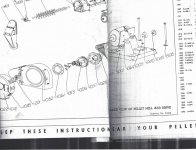Bill in PA
Hot Rolled
- Joined
- Jan 25, 2011
- Location
- Fairfield, PA
Hello,
Customer wants me to make a replacement yoke to fit on an existing shaft. He gave me two to work with. He does not know how the yoke is joined to the shaft. I could see no joints or seams so I bored into the end of the yoke. Found no seams except for a small void, about the size of a marble about 1" deep about on center. I thought maybe that this was end of the shaft. Continue to bore to the depth of the yoke, about 3" deep and 4" diameter (the shaft is 5" round). Found nothing. Put the shaft in the band saw and cut the yoke off. Appears to be one-piece.
The yoke appears to be cast steel. The shaft may be 1045. Cuts easy but does have hard spots where a bearing was torched off. No hard spots while boring/facing. No trouble cutting with the band saw.
In the photo of the end of the shaft, you can see a seam. That is a ring that is pressed on. You can see it on the other shaft where I knocked it off.
Any thoughts would be great about how this was manufactured.
Photos are of a brand new shaft assembly, 2nd used shaft assembly, sawed-off yoke and shaft.
Thanks,
Bill





Customer wants me to make a replacement yoke to fit on an existing shaft. He gave me two to work with. He does not know how the yoke is joined to the shaft. I could see no joints or seams so I bored into the end of the yoke. Found no seams except for a small void, about the size of a marble about 1" deep about on center. I thought maybe that this was end of the shaft. Continue to bore to the depth of the yoke, about 3" deep and 4" diameter (the shaft is 5" round). Found nothing. Put the shaft in the band saw and cut the yoke off. Appears to be one-piece.
The yoke appears to be cast steel. The shaft may be 1045. Cuts easy but does have hard spots where a bearing was torched off. No hard spots while boring/facing. No trouble cutting with the band saw.
In the photo of the end of the shaft, you can see a seam. That is a ring that is pressed on. You can see it on the other shaft where I knocked it off.
Any thoughts would be great about how this was manufactured.
Photos are of a brand new shaft assembly, 2nd used shaft assembly, sawed-off yoke and shaft.
Thanks,
Bill











